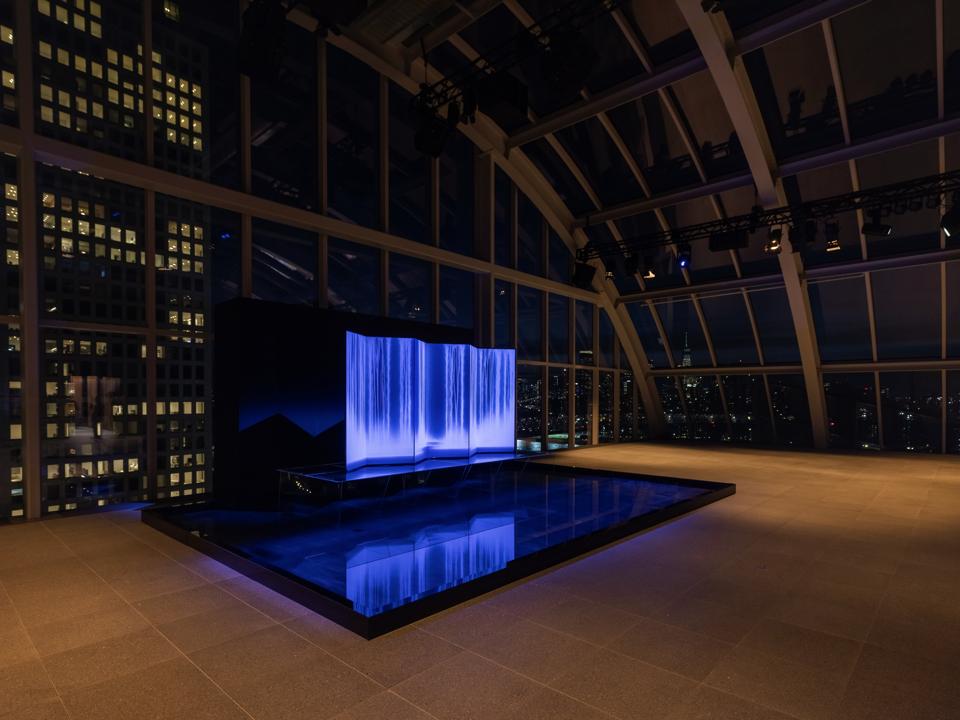Ten tranquil shades of purple borrowing from Kokimurasaki, a traditional Japanese color name meaning “deep purple” and evoking nobility, convey key functions of natural ecosystems and human society to depict a waterfall. Gazing deeply at the monumental canvas, Waterfall on Colors Hibiki, a feeling of calm intensity cascades over the viewer to foster serenity born from the irregularities of nature.
Internationally-renowned Japanese Painter Hiroshi Senju – best known for his contemporary interpretation of traditional Japanese painting by using Japanese materials to execute modern, abstract, gestural techniques, particularly his large-scale, monochromatic depictions of waterfalls – immerses himself in a painstaking process of filling canvas panels with water and hokaimatsu, a natural marble powder used as a pigment in painting, to enable the flow of water to freely distribute the pigment. The resulting dynamic, naturally-guided patterns honor the Japanese tradition of deeply intertwining art with nature, which underscores a profound connection rooted in ancient Shintō beliefs that nature is sacred. The ethos carries into Buddhist concepts of transience and interconnectedness.
In collaboration with The House of Suntory, Senju masterfully reimagines the relationship between whiskey, art and nature, creating a limited-edition presentation box for two multiple award-winning and limited blends, Hibiki 21 Years Old and Hibiki 30 Years Old. It’s a rare corporate partnership for Senju, whose work is shown in prominent museums worldwide, including the Metropolitan Museum of Art and Brooklyn Museum in New York, the Museum of Contemporary Art, Los Angeles, and the Museum of Modern Art, Toyama in Japan, underscoring his passion for the brand. Senju also houses his own museum, the Hiroshi Senju Museum Karuizawa, and his monumental works are displayed in various public and private spaces such as Tokyo’s Haneda Airport and the Grand Hyatt Tokyo.
A major exhibition at Sundaram Tagore Gallery in New York showcasing waterfall works painted with fluorescent pigments expands Senju’s diverse palette, which includes his signature black-and-white style and vibrant colors like blue, red, and platinum.
On view through November 15, Hiroshi Senju: Physical/Metaphysical presents a bold new expression of Senju’s oeuvre by hanging paintings under ultraviolet (UV) light to embrace a contemporary context and transform the viewer’s perception of light and energy.
Revealing how various environments impact Senju’s work, Waterfall on Colors Hibiki was staged this week in a massive room with spectacular views at The Refinery at Domino in Brooklyn for an intimate dinner crafted by Atsushi Tanaka, owner of the Michelin-starred restaurant A.T in Paris. Waterfall on Colors Hibiki amplifies Senju’s bridging of traditional Japanese nihonga painting techniques with a minimalist sensibility informed by his time in New York, complemented by Tanaka’s artistically presented, contemporary, Japanese-inspired, creative tasting menu. The chef married each dish with Hibiki, both through infusion into the cuisine and with cocktail and spirit pairings.
The starter of tuna, marigold, and fermented plums was magnified by the nuanced tartness and sourness of a Hibiki ume highball. Unlike a lackluster whisky and soda, a Japanese highball blends quality ingredients, expert technique, and a distinctively subtle flavor profile that complements Japanese cuisine. The main plate of duck, an array of condiments, and carrots, was paired with Hibiki Japanese Harmony and sobacha, a traditional Japanese herbal tea made from roasted buckwheat kernels. The sobacha’s nutty, earthy, and slightly sweet taste punctuates and balances the rich, fatty flavor of the waterfowl poultry.
A luscious dessert of blueberry and hinoki, or “fire tree” in Japanese, was a stunner. Revered as a sacred wood in Japan, hinoki, or Japanese Cypress, has been traditionally used to construct temples, shrines, and traditional Noh theaters. The subtle, fresh, and citrusy aroma of the hinoki and the coolness of the not-too-sweet course married elegantly with Hibiki 21 Years Old, served in oyuwari style, which means “cut with hot water.” Finally guests enjoyed Hibiki 30 Years Old, savoring its complexity born from aging in rare Japanese Mizunara oak barrels to impart distinctive notes of sandalwood and spice and velvety texture with a long finish that hints at smokiness.

